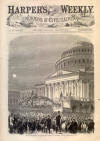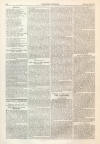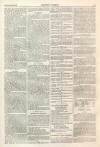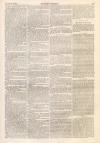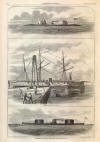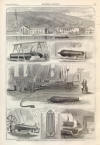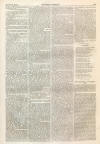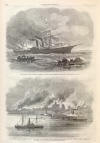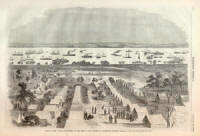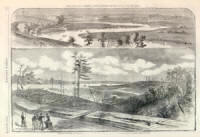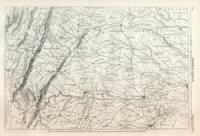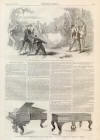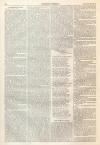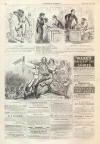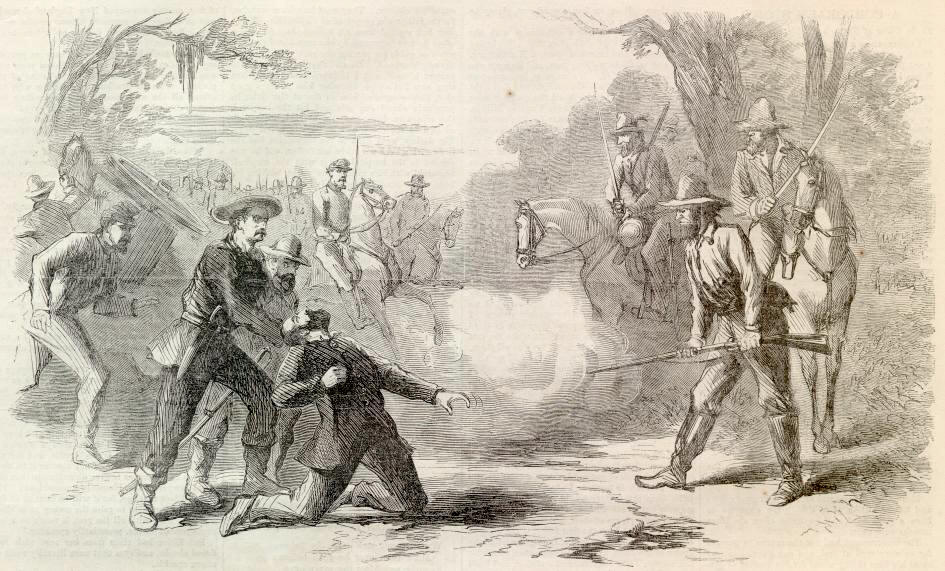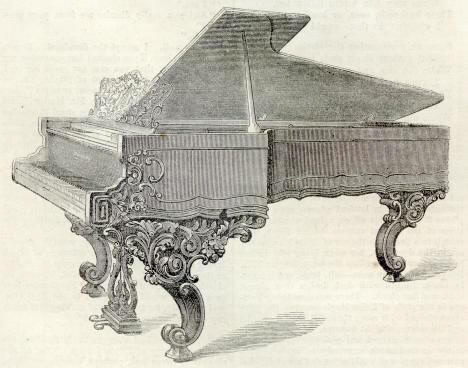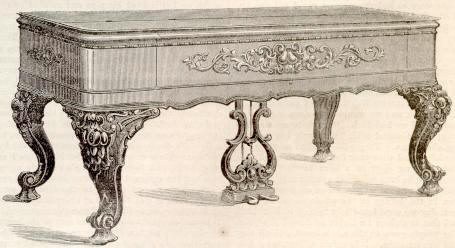Steinway Pianos
|
|
This Site:
|
AUGUST 23, 1862.] HARPER'S WEEKLY. 541 THE MURDER OF GENERAL ROBERT L. McCOOK, NEAR SALEM, ALABAMA.—[SEE PAGE 530.]STEINWAY'S PIANOS.WE publish below two illustrations of STEINWAY's PIANOS, made by Steinway & Sons, of Walker Street, New York City, which received a first prize medal at the London Exhibition, having been characterized by the jurors as "Powerful, clear, brilliant, and sympathetic tone of piano, with excellent workmanship shown in grand and square pianos." In order to show how widely these pianos are appreciated abroad, we subjoin a few extracts. The London News of the World (illustrated) says of these pianos: "These magnificent piano, manufactured by Messrs. Steinway & Sons, of New York, are without doubt the musical gems of the Exhibition of 1862. They possess a tone that is the most liquid and bell-like we have ever heard, and combine the qualities of brilliancy and great power without the slightest approach to harshness. We will describe, as well as we are able, the peculiarities belonging to them. The bass-covered strings are carried over and across the lower steel ones. By adopting this plan the bridge on which the covered strings rest is in the middle of the back part of the sounding-board, which naturally gives them a greater amount of vibration than if the bridge were placed on one side of the sounding-board, as in our English pianos. The manner in which the metallic plate and bare are arranged is very excellent, the whole being cast in one piece, by which means all possibility of jarring (which frequently occurs when the bars and plate are made separately) is done away with. Messrs. Steinway's patent repetition action is another great feature in these pianos, for although it produces a repeat of the most perfect kind—has a check that is firm and unvarying, and of a most ingenious character—the whole thing is so extremely simple that it can be understood almost at a glance by any ordinary piano-forte tuner; and we feel bound to add that they have an elasticity of touch and firmness of blow that we have rarely, if ever, seen surpassed. "In grand pianos, and indeed in all which have a great length of string, there is a difficulty in damping or stopping the sound of the note directly the finger is taken off. This difficulty, too, has been overcome by Messrs. Steinway, for they use a damper which stops the sound as soon as the hands are raised from the keys. The American makers are generally very elaborate in the getting up of the cabinet work about their pianos. They are adorned with very rich carved work, are massive and elegant in their appearance, and have a polish on them which makes the surface of the wood look more like a piece of plate-glass than what it really is. We would advise all who have a taste for music, and are fond of hearing a good piano, to visit these magnificent instruments the next time they go to the International Exhibition. They are to be found in Class 16, United States Department. We are informed that Messrs. Steinway are to receive a first-class medal for their pianos. The whole of Messrs. Steinway and Sons' pianos have been purchased by the enterprising firm of Cramer, Beale, & Wood, the proprietors of the great Piano-forte Gallery in Regent Street, who, we understand, are appointed the sole agents for them in England." The special correspondent of the New York Times writes: "In Class 16 there are four exhibitors, two of whom receive the medal. This is the musical instrument class, and I am not wrong in saying that it has been the great feature of the American Department. In a former letter I referred to the extraordinary excitement that had been occasioned among piano-forte makers and professors by the startling power and excellence of Messrs. Steinway & Sons' instruments. The American Court was crowded with the curious in such matters; all the best players in London tried the pianos, and some of a burglarious disposition even went so far as to break the instruments open when they happened to find them locked. Several weeks ago the two grands and two squares were sold to Messrs. Cramer, Beale, & Wood, who were so satisfied with their bargain, and confident that a European business could be established by Messrs. Steinway & Sons, that they have ever since announced themselves as their agents, and, as I am informed, have forwarded an extensive order for upright pianos. Four other cash applications were made for the purchase of these particular instruments, and I am confident that if a dozen 'grands' were here they would go off like hot cakes. The jurors in this class were as follows: "W. Sterndale Bennett, Mus. D., London ; J. R. Black, M. D., United States; Right Honorable Sir George Clerk, F.R.S., Chairman, Edinburgh; Fetis, Deputy-Chairman, Belgium; Lissajous, France; Rev. Sir F. Gore Ousely, Bart., Mus. D., Oxford; Ernst Pauer, Austria; William Pole, Mus. B., F.R.S., Secretary, London; J. Schiedmayor, Zoll-Verein; Earl of Wilton, G.C.H., London; Henry Wylde, Mus. D., London. "And the awards are: Steinway & Sons, medal, 'Powerful, clear, and brilliant tone of piano, with excellent workmanship shown in a grand piano and a square piano of very large dimensions.' Messrs. Steinway's indorsement by the jurors is emphatic, and stronger and more to the point than that of any European maker." M. Henri Hoche, one of the most competent musical critics in France, says, in the Presse Musicale of Paris: "The firm of Steinway & Sons, from New York, exhibits two pianos—one grand piano and one square piano—both of which have particularly attracted the attention of the jury. This firm, not known among the exhibitors of the first exhibition in London, has taken in a very short time an astonishing development. Messrs. Steinway & Sons have, to say so, the monopoly to sell pianos in America, and in New York they have considerably outstripped the other manufacturers. Undoubtedly, therefore, Messrs. Steinway may claim to be classed with Messrs. Erard, Pleyel, Broadwood, etc. Such importance naturally called the attention of the international jury to the Steinway pianos; but there were better reasons still for their attention, and the first of these reasons is the excellency of the pianos. This firm is also the only one which distinguished itself in the manufacturing of pianos by new inventions, worthy of being favorably considered." M. Hoche continues his letter by comparing the old and new method of piano making, mentioning especially that Messrs. Steinway prepare the wood which they choose with the utmost care, and only take the very best materials for their pianos. He after this praises the invention of overstringing, for which Messrs. Steinway have a patent, and says: "I have been able to judge upon the effect of this new method, and can tell you that the square piano of Messrs. Steinway fully possesses the tone of a grand piano; it sounds marvelously. The ample sound, the extension, the even tone, the sweetness, the power, are combined in this piano as in no other piano I have seen, and this is the result of the new inventions which I mentioned." About the grand piano the writer makes the following eulogistic remarks: "The grand piano unites in itself all the qualities which you can demand of a concert piano. The character, the power, and the even tone are most remarkable. The touch is comparatively light; it is adapted for every shade of expression, and in every part the instrument will develop, according to the wish of the player, power, sweetness, and especially that soft tone which is necessary for accompaniment. I do not hesitate to say that this piano is by far better than all the English pianos which I have seen at the Exhibition, including the pianos of Broadwood. Finally, I can tell you that Messrs. Steinway & Sons are going to receive the medal for sonority and clearness, brilliancy and sympathetic tone of their pianos."
THE LOSS OF THE "GOLDEN
|
||||||||||||||||||||||||||||||
|
|
||
|
|
Site Copyright 2003-2018 Son of the South. For Questions or comments about this collection, contact paul@sonofthesouth.net |
|
|
Are you Scared and Confused? Read My Snake Story, a story of hope and encouragement, to help you face your fears. |
||
